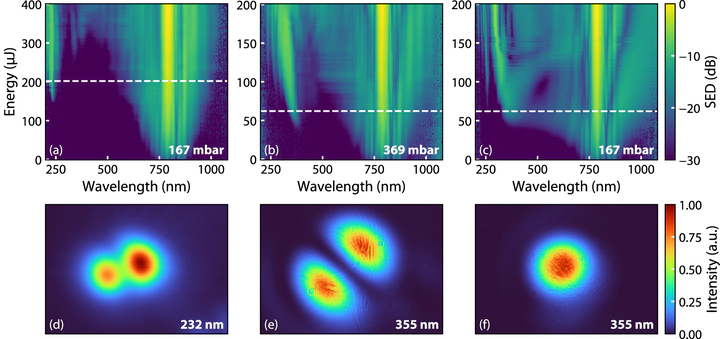Soliton self-compression and resonant dispersive wave emission in higher-order modes of a hollow capillary fibre
 Experimental demonstration of self-compression and RDW emission in a higher-order mode. Top row: output spectrum of the HCF (on a logarithmic colour scale) as a function of incident pump energy at the indicated argon pressures when coupling at an angle (a), (b) and when coupling along the optical axis (c). Bottom row: far-field beam profile of the dispersive wave, bandpass-filtered around the indicated wavelengths, when pumping with the energies indicated by the white dashed line in the top row.
Experimental demonstration of self-compression and RDW emission in a higher-order mode. Top row: output spectrum of the HCF (on a logarithmic colour scale) as a function of incident pump energy at the indicated argon pressures when coupling at an angle (a), (b) and when coupling along the optical axis (c). Bottom row: far-field beam profile of the dispersive wave, bandpass-filtered around the indicated wavelengths, when pumping with the energies indicated by the white dashed line in the top row.
Abstract
We investigate soliton self-compression and ultraviolet resonant dispersive wave emission in the higher-order modes of a gas-filled hollow capillary fibre (HCF). Our simple analytical scaling rules predict shorter required waveguides and different energy scales when moving from the fundamental to higher-order modes. Experimentally, we demonstrate soliton self-compression and ultraviolet dispersive wave emission in the double-lobe LP11 mode of an argon-filled HCF, which we excite by coupling into the fibre at oblique incidence. We observe the generation of ultraviolet dispersive waves which are frequency-shifted and more narrowband as compared to fundamental-mode generation due to the stronger modal dispersion, and a suppression of the supercontinuum between the dispersive wave and the pump pulse. With numerical simulations, we confirm the predictions of our scaling rules and find that the use of higher-order modes can suppress photoionisation and plasma effects even while allowing for much higher pulse energy to be used in the self-compression process. Our results add another degree of freedom for the design of hollow-waveguide systems to generate sub-cycle field transients and tuneable ultrashort laser pulses.